Last Updated: 4/17/2024
Article Credit: ShootTheCore, Furrtech, cpsystem3,Eduardo Cruz, ExodusEmulator, Caius, Frank_fjs, twistedsymphony, Jotego
Main Board
The Sega System 16B main board contains all the processing logic to run the game. The Sega part number for it is 171-5347.
Note that these boards are NOT JAMMA pinout and need an adapter to be properly connected to a JAMMA harness.
Depending on the protection scheme used for the particular game, the Main CPU may utilize encryption, the Sound CPU may utilize encryption, and an MCU may or may not be present – see Protection Measures below for more details.
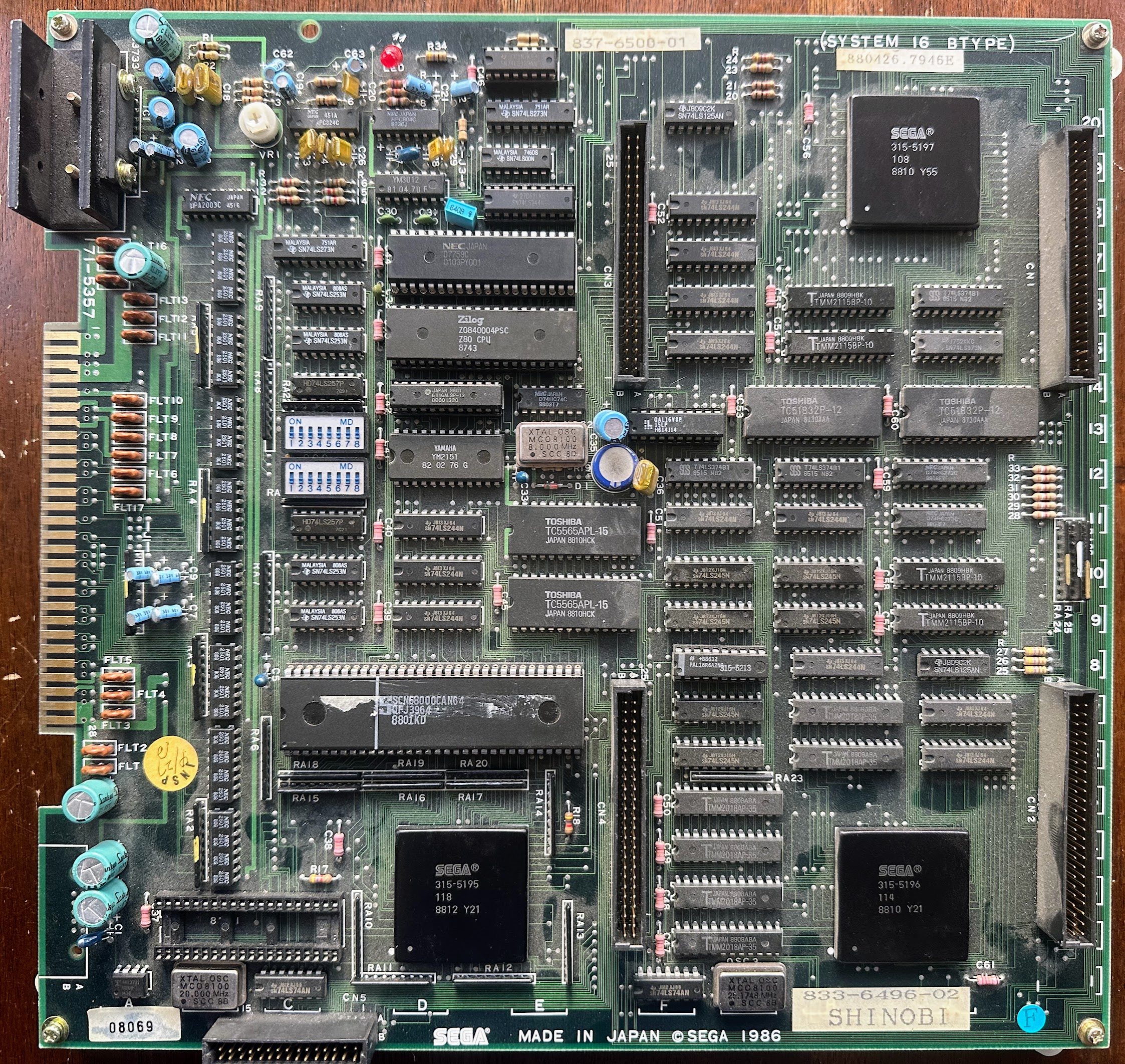
Photo Credit: ShootTheCore
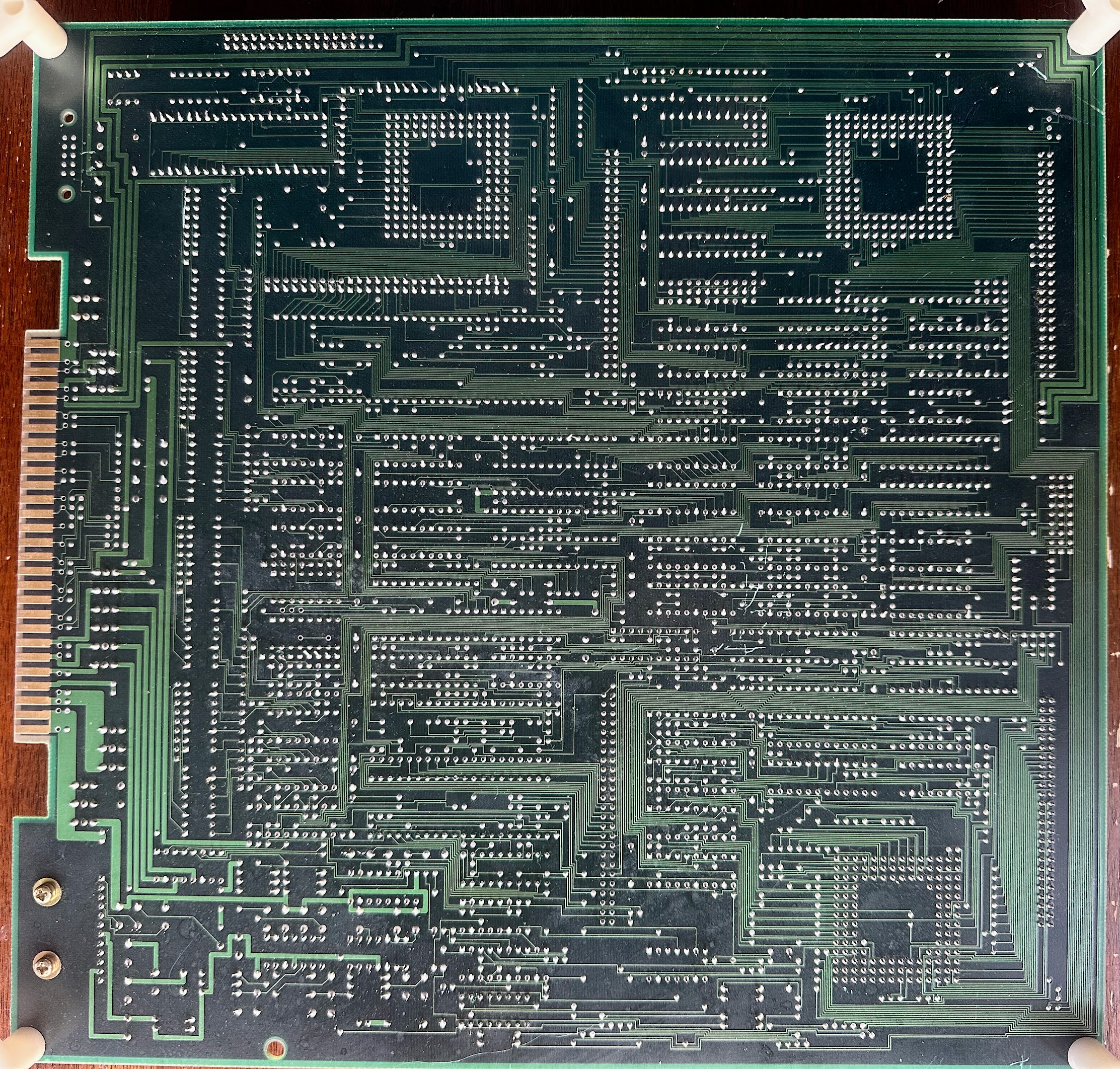
Photo Credit: ShootTheCore
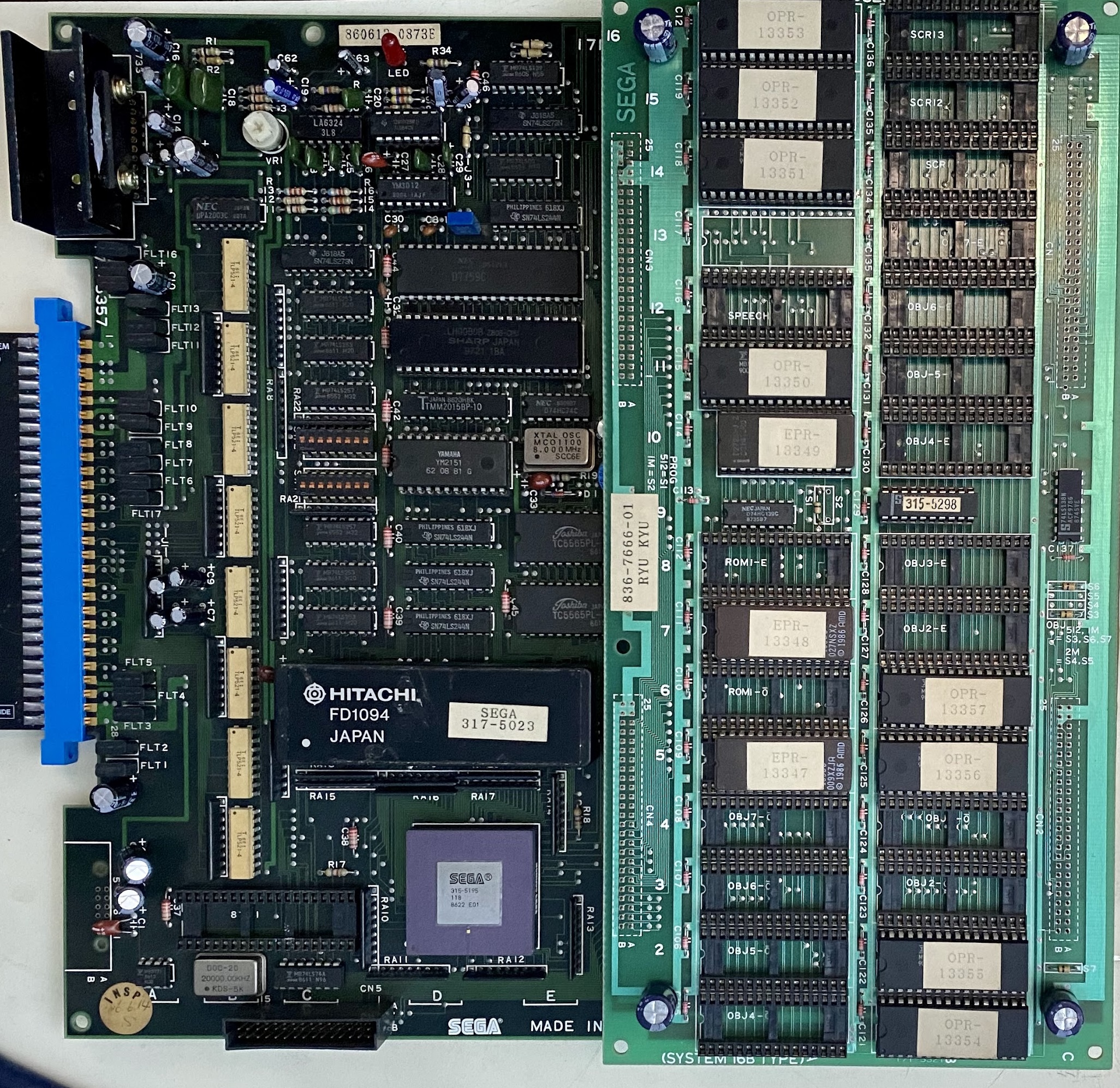
Photo Credit: ShootTheCore
Notable ICs
| IC | Function | Location |
| Hitachi FD1094 CPU (encrypted) Signetics SCN68000C8N64 68000 CPU (unencrypted) | 10.0 Mhz Main CPU | C9 |
| NEC MC-8123B CPU (encrypted) Zilog Z8040004PSC Z80 CPU (unencrypted) | 4.0 Mhz Audio CPU | D15 |
| Yamaha YM2151 | FM Audio | D12 |
| Yamaha YM3012 | Audio DAC for the YM2151 | D18 |
| NEC D7759C | Audio Speech Synth | D16 |
| Sega 315-5195 | Memory Mapping | D4 |
| Sega 315-5196 | Sprite Generation | I4 |
| Sega 315-5197 | Tilemap Generation | I18 |
| Intel i8751 | MCU (Copy Protection) | B2 |
ROM Board (credit: ExodusEmulator)
There are four variants of the ROM board used with System 16B:
- 171-3538: ROMs only. Support for 32K/64K ROMs
- 171-5521: Banking register added to the middle. Support for 512K/1M/2M ROMs
- 171-5704: Jumper pins added to control banking. 512K/1M ROMs
- 171-5797: Adds Sega 315-5250 68000/Z80 mapping interface and an additional banking register. 512K/1M ROMs
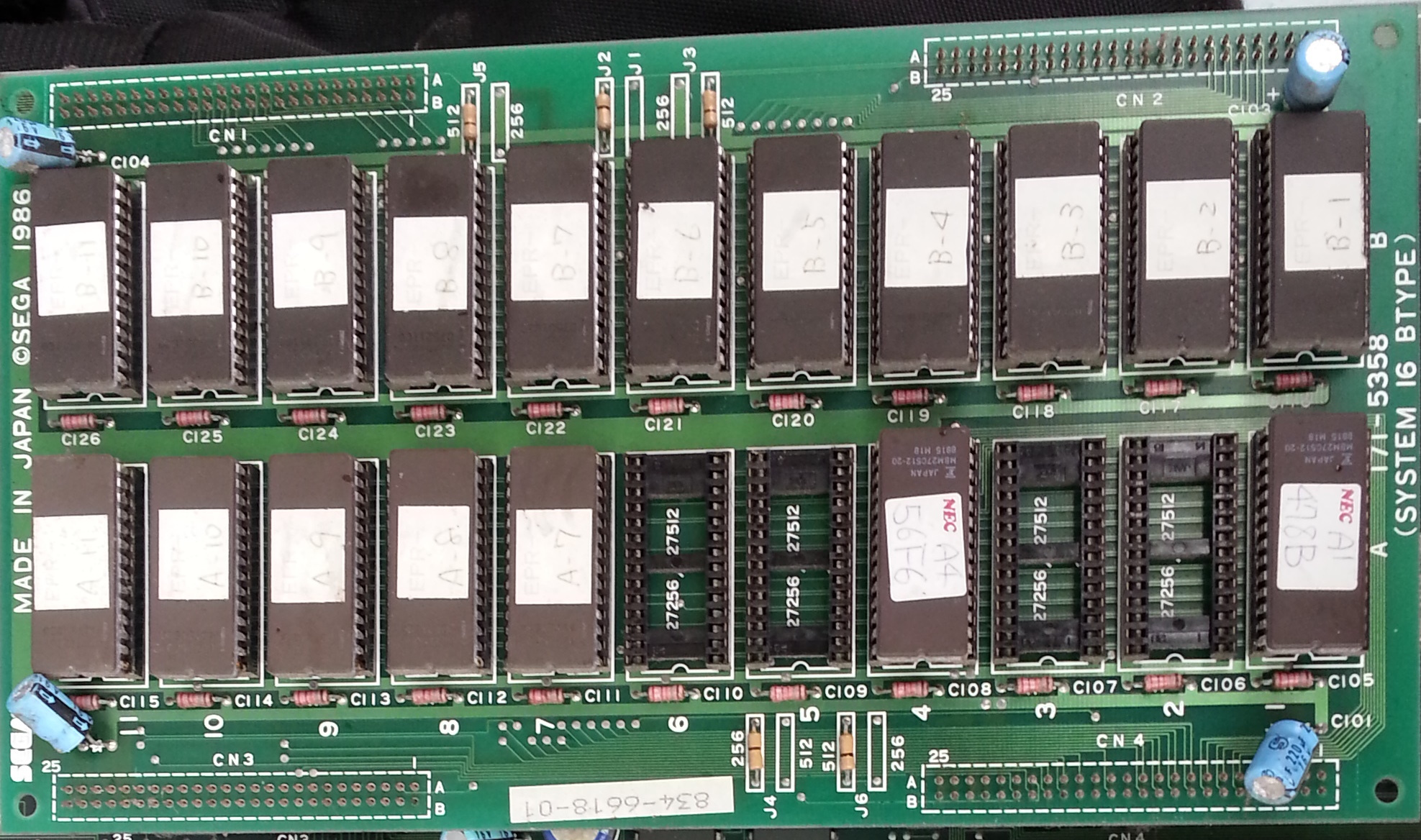
Photo Credit: ExodusEmulator
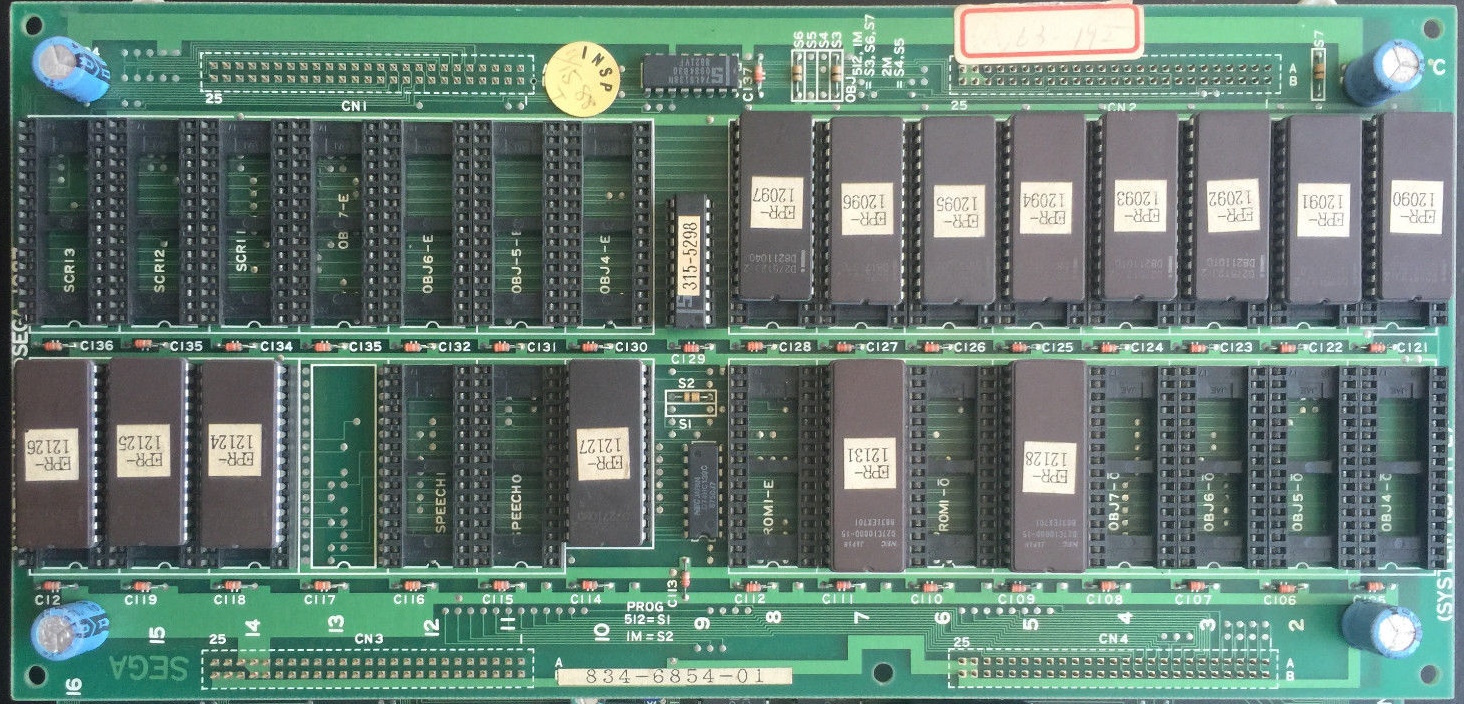
Photo Credit: ExodusEmulator

Photo Credit: ExodusEmulator
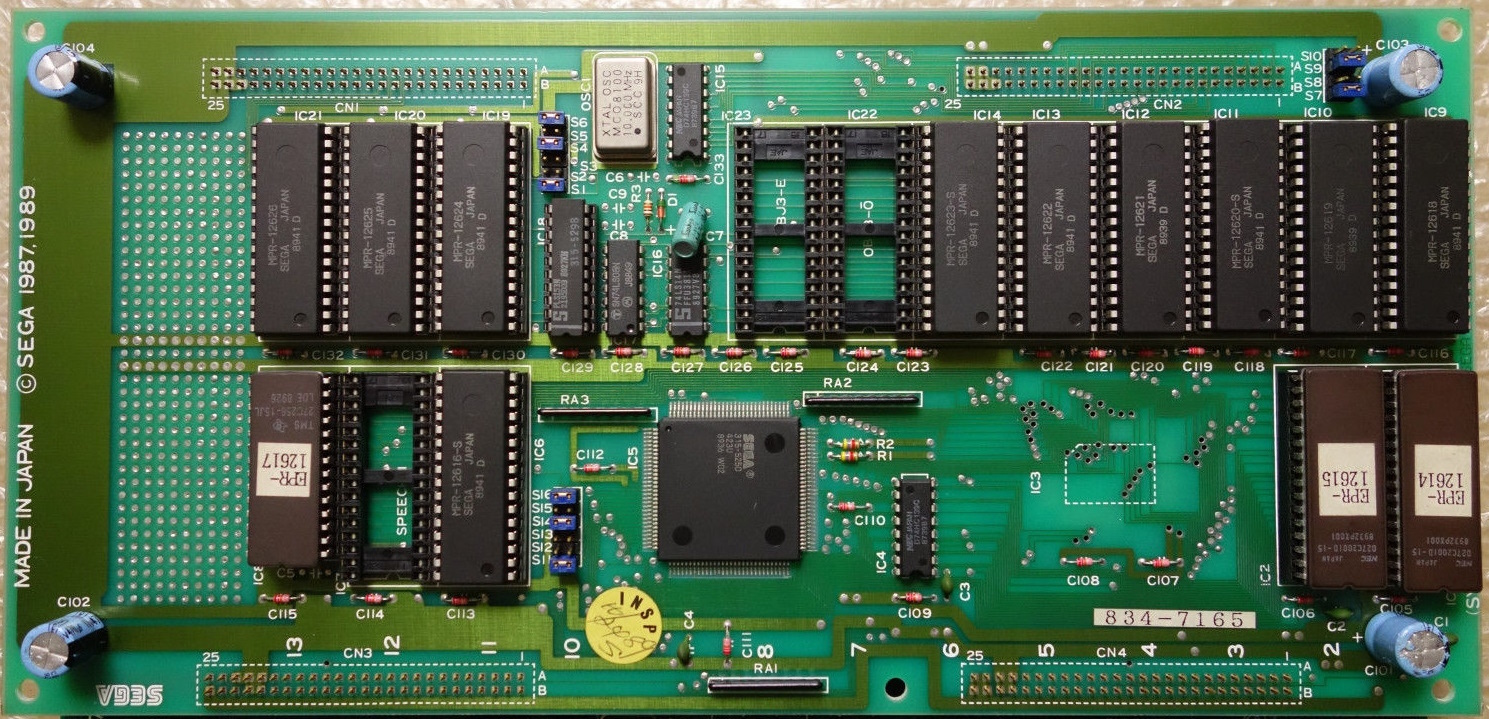
Photo Credit: ExodusEmulator
Source: ExodusEmulator
Daughter Boards (credit: ExodusEmulator)
There are two daughter boards used with some System 16B games for additional control IO:
- 171-5437 / 834-6180: Trackball input
- 834-6523: 4 Player input
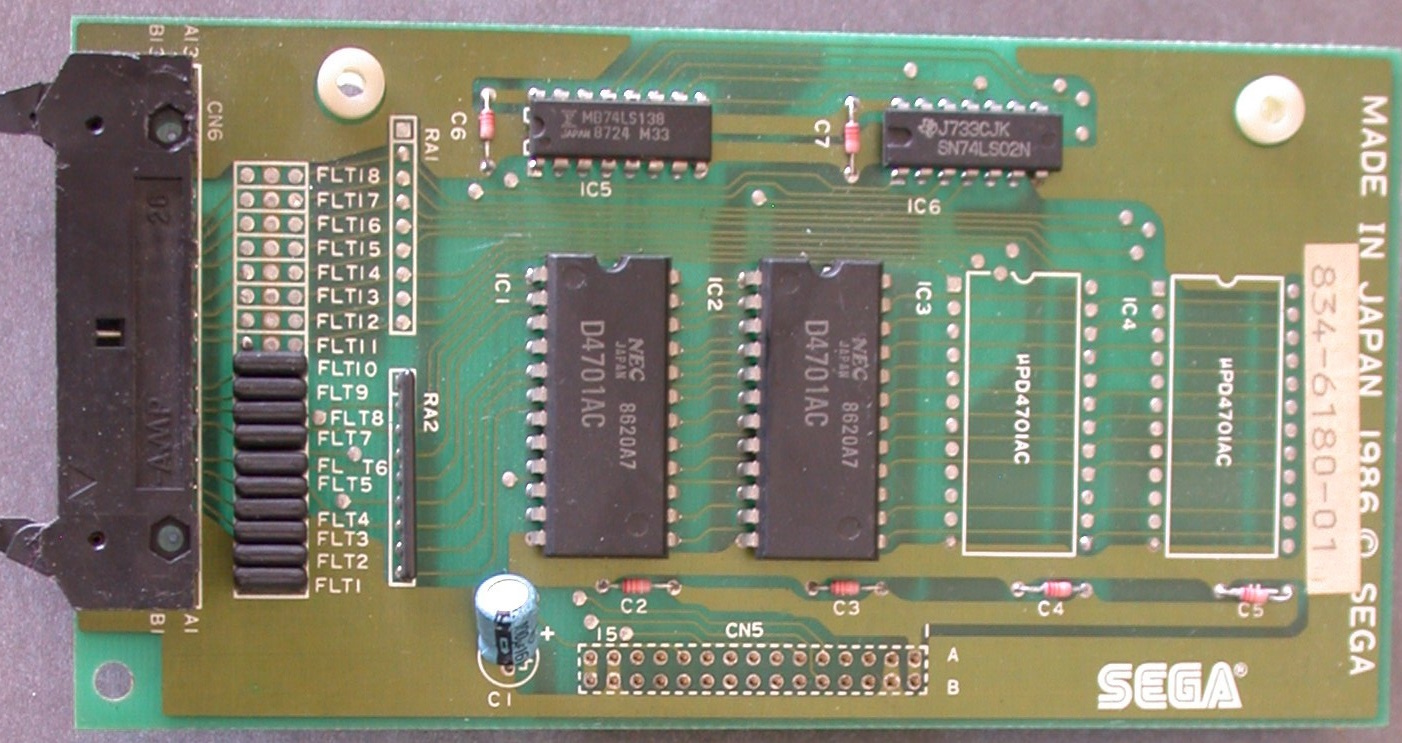
Photo Credit: ExodusEmulator
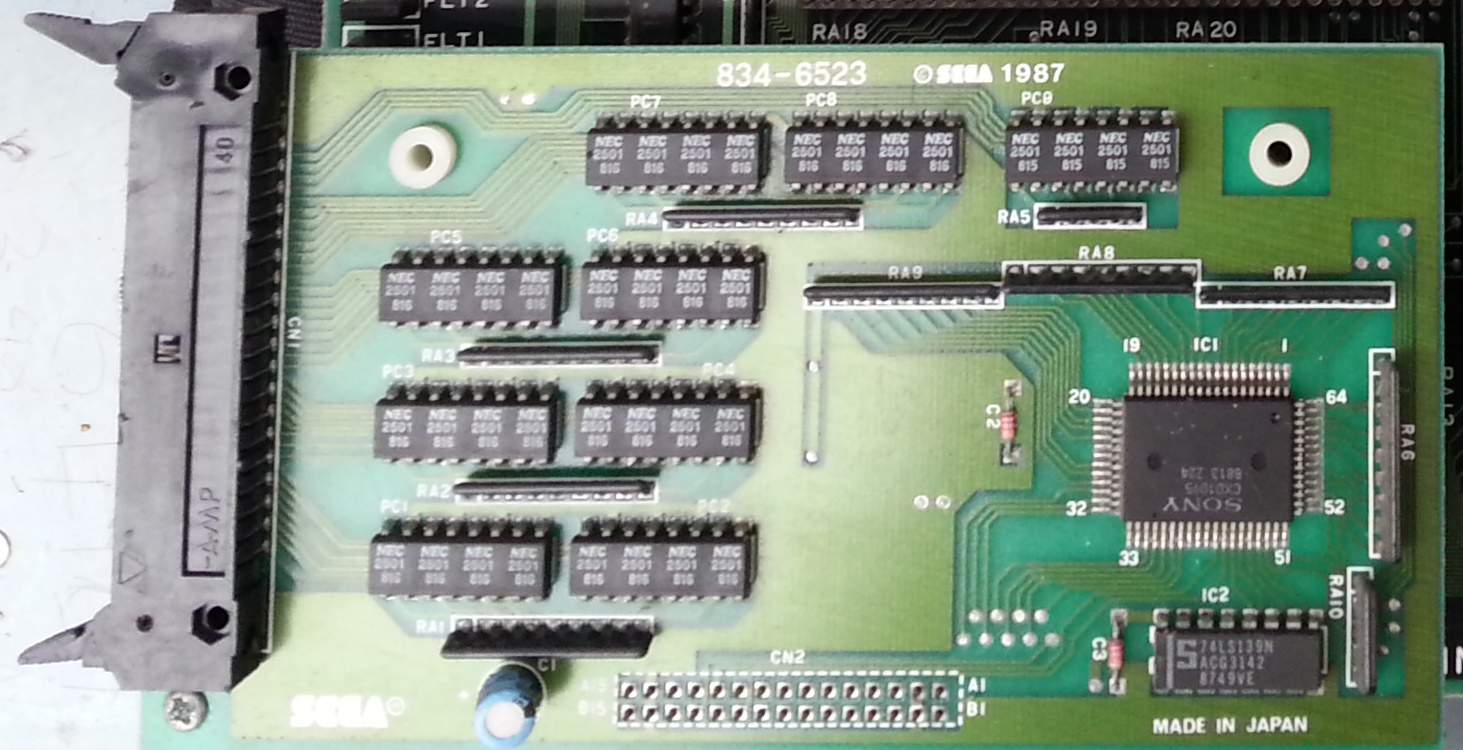
Photo Credit: ExodusEmulator
Source: ExodusEmulator
Board Variants
The Sega System 16B board was identical between regions for the full lifecycle of the hardware. However, it was heavily bootlegged and thus there is a wide variety of cloned boards. Compared to the original games, cloned boards may have differences in graphics, sound, gameplay and speed. The bootlegs look dramatically different from the Sega originals and are easy to distinguish from the real thing.
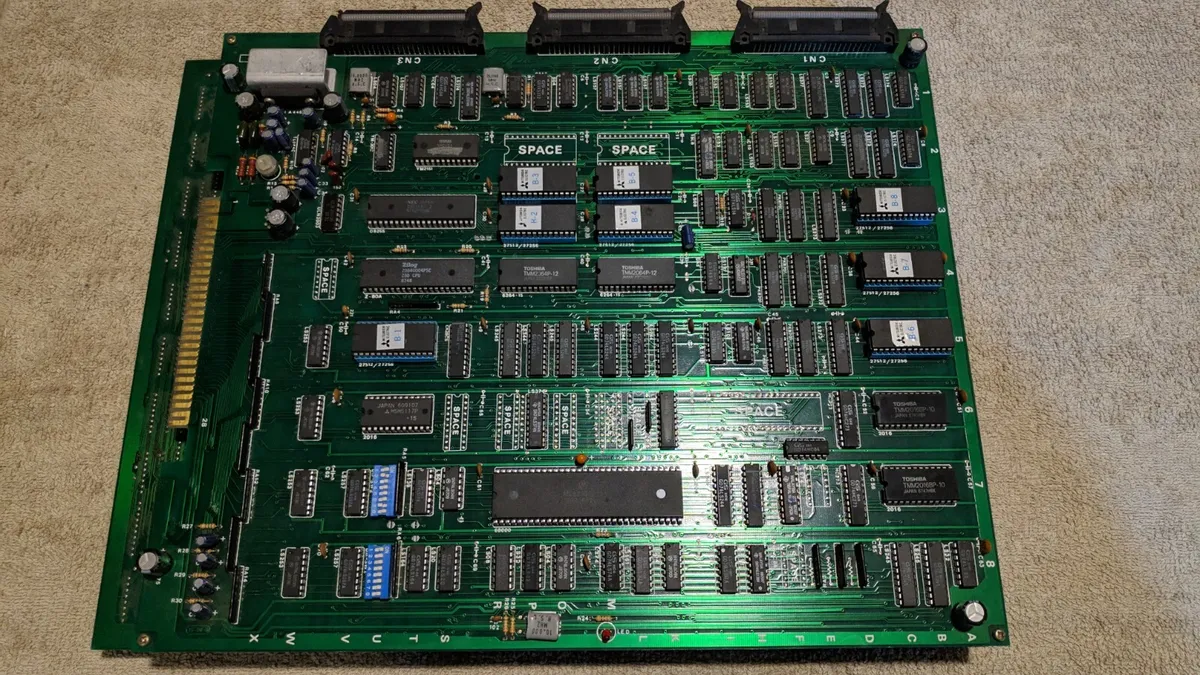
Photo Credit: Ebay
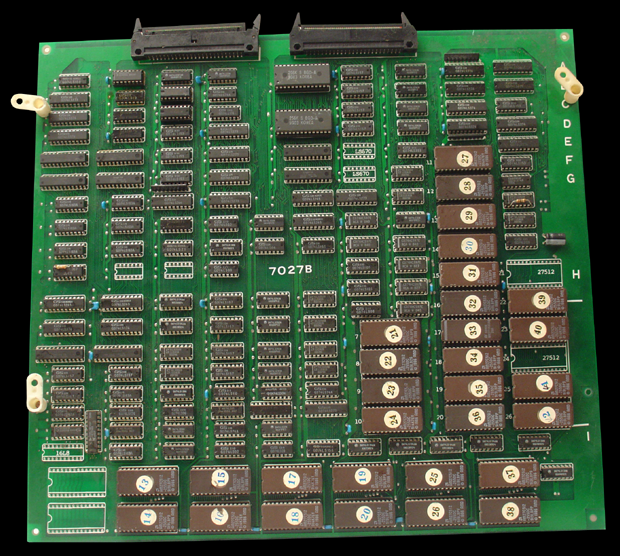
Photo Credit: Ebay
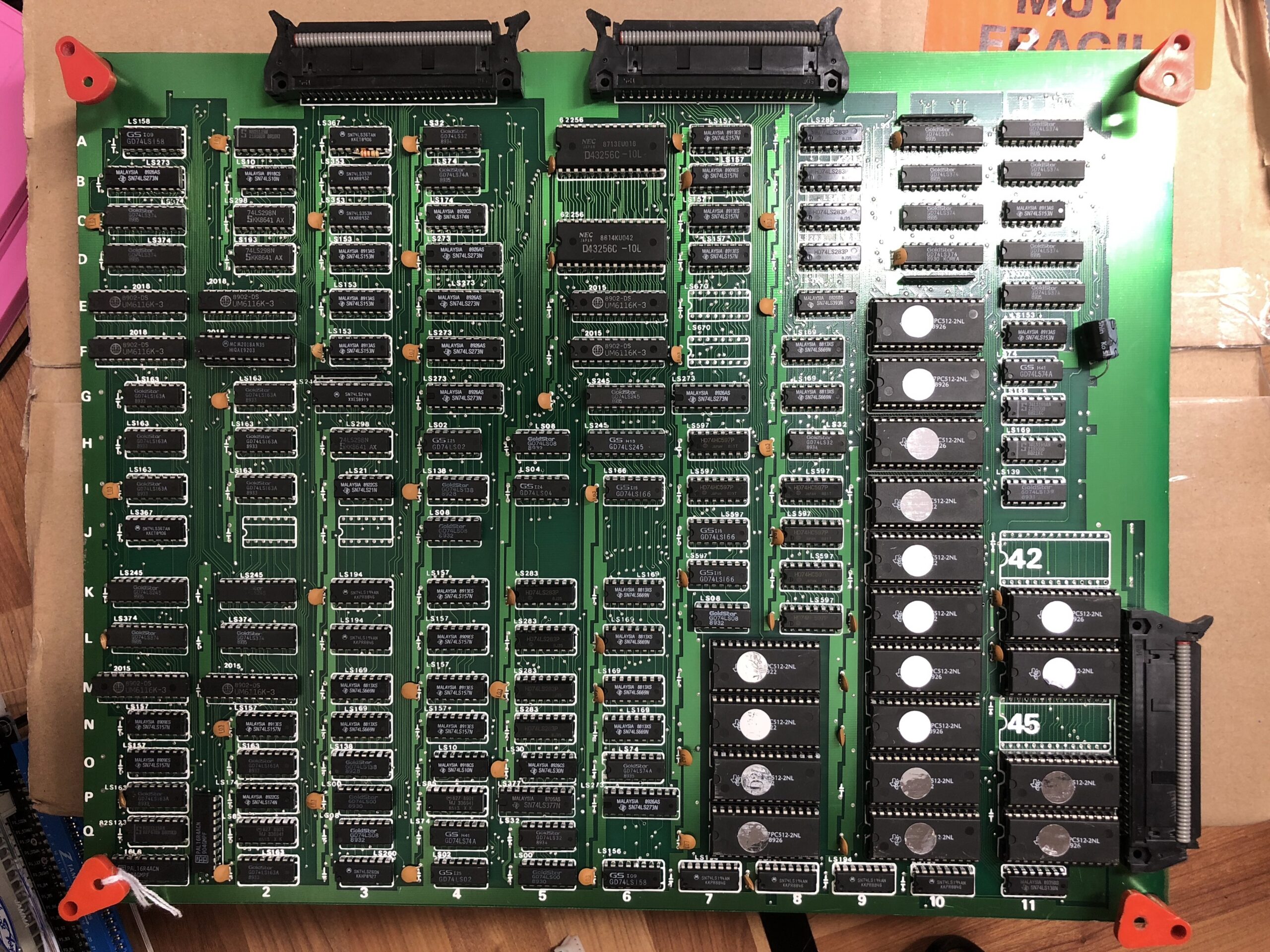
Photo Credit: Ebay
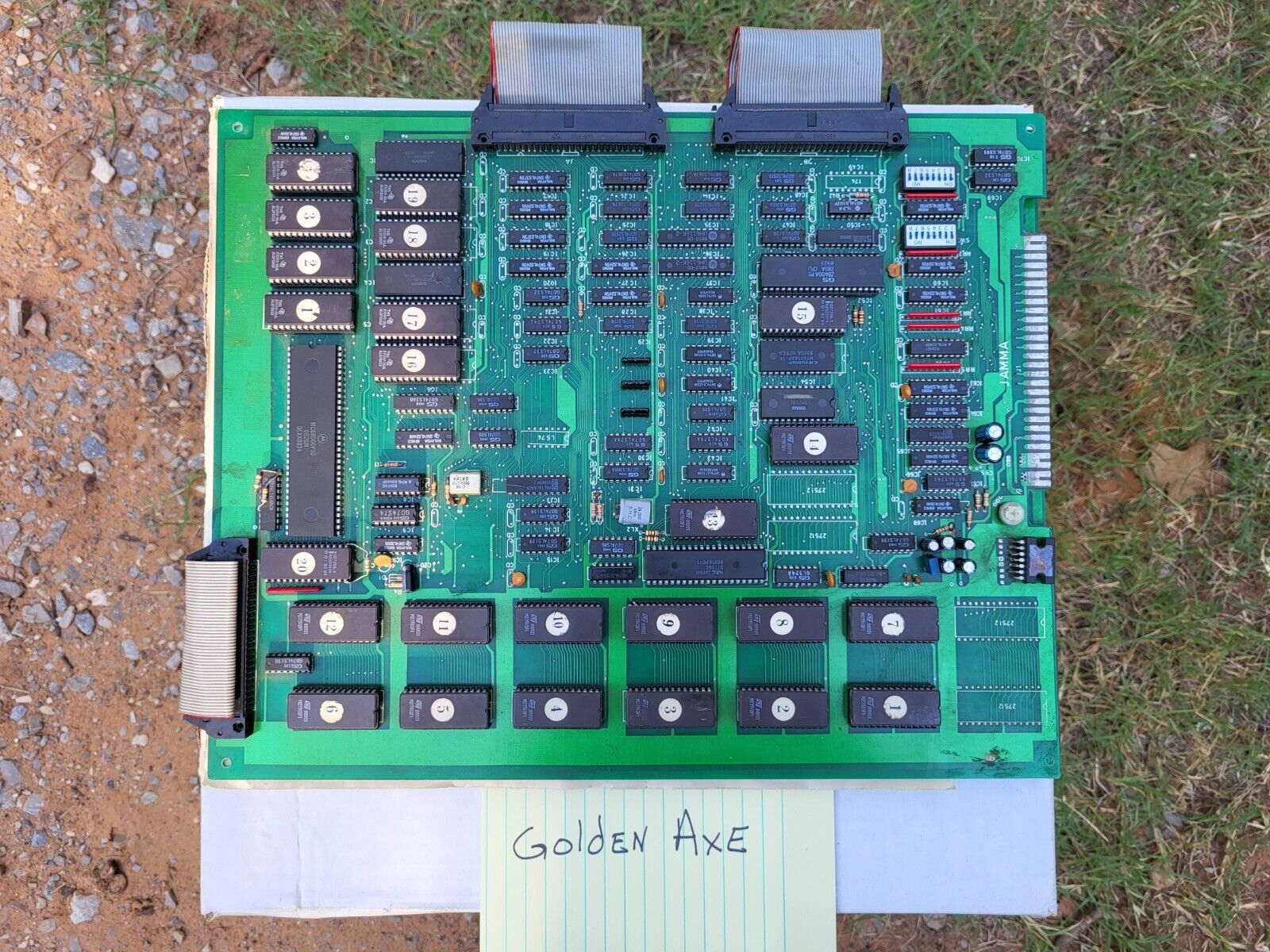
Photo Credit: Ebay
Common Issues and Quirks
System16B boards are NOT JAMMA pinout and need an adapter to be properly connected to a JAMMA harness.
System16B boards draw more power than average, so adjust your arcade PSU accordingly when swapping one into your cabinet or SuperGun.
It is common for the battery in the Main CPU or Sound CPU to die if they are encrypted, causing the game to either not boot or not have sound respectively. See “Copy Protection” below for details and resolution.
It is common for the TL084 OpAmp located at D19 to fail, resulting in faint or garbled audio output. Replacement parts are easy to source.
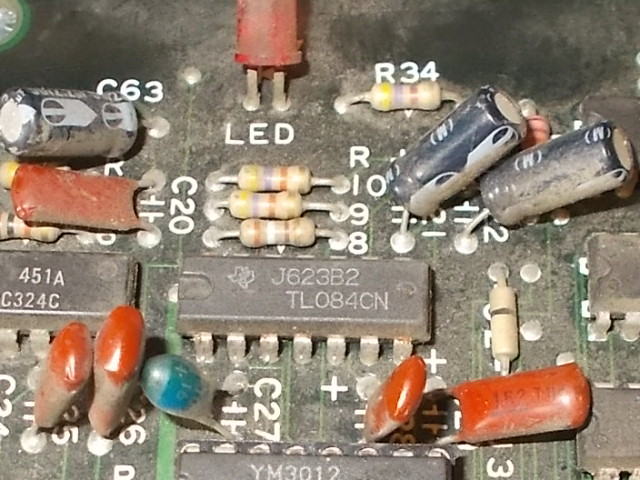
Photo Credit: Caius
Capacitor List (credit: Frank_fjs)
| Location | Capacitance | Voltage | Part No. |
| C2 | 470 uF | 16 V | ECA-1CM471B |
| C3 | 470 uF | 16 V | ECA-1CM471B |
| C4 | 470 uF | 16 V | ECA-1CM471B |
| C6 | 1 uF | 50 V | ECA-2VM010B |
| C7 | 1 uF | 50 V | ECA-2VM010B |
| C8 | 1 uF | 50 V | ECA-2VM010B |
| C9 | 1 uF | 50 V | ECA-2VM010B |
| C10 | 470 uF | 16 V | ECA-1CM471B |
| C16 | 470 uF | 16 V | ECA-1CM471B |
| C11 | 10 uF | 16 V | ECA-1CM100B |
| C12 | 10 uF | 16 V | ECA-1CM100B |
| C13 | 220 uF | 16 V | 647-URS1C221MPD1TA |
| C14 | 100 uF | 16 V | ECA-1CM101B |
| C15 | 100 uF | 16 V | ECA-1CM101B |
| C19 | 47 uF | 16 V | ECA-1CM470B |
| C62 | 2.2 uF | 50 V | ECA-2AM2R2B |
| C63 | 2.2 uF | 50 V | ECA-2AM2R2B |
| C21 | 2.2 uF | 50 V | ECA-2AM2R2B |
| C22 | 2.2 uF | 50 V | ECA-2AM2R2B |
| C34 | 220 uF | 16 V | 647-URS1C221MPD1TA |
| C35 | 0.1 F | 5.5 V | 80-FYD0H104ZF or 80-FG0H104ZF |
ROM Details (credit: MAME)
Due to the variety of ROM boards used across the System16B games, consult the MAME Driver for game-specific ROM assignments.
When replacing a mask ROM with an EPROM, consult this reference chart by twistedsymphony:
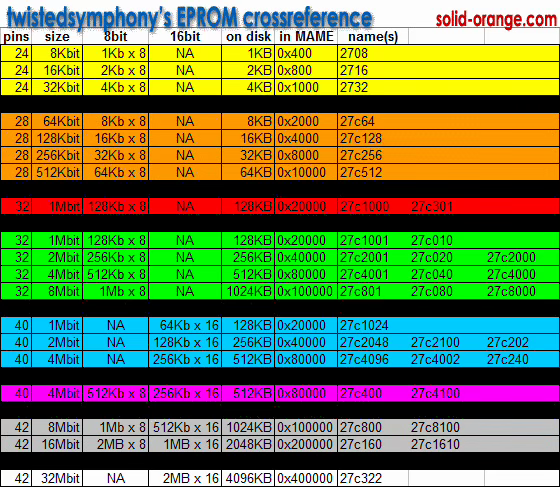
Protection Mechanisms
Sega implemented four different protection mechanisms to prevent arcade operators from swapping one System 16B game to another by installing a new set of ROM chips. Games may implement one or more of these protection mechanisms:
- 68000 Main CPU Encryption
- Z80 Sound CPU Encryption
- Intel i875 Memory Control Unit
- ROM Board variants
Main CPU Encryption (credit: Eduardo Cruz)
Some games encrypt the 68000 code executed by the Main CPU. Those games use a Hitachi FD1094 CPU, which is a Motorolla 68000 clone with a RAM-based decryption key that matches up with the encryption key used on Main CPU ROMs. If the battery that maintains the RAM storing the decryption key dies then the key is lost and the main CPU will crash at boot – the game will sit at a black screen at boot (“suicide”).

Photo Credit: ShootTheCore

Photo Credit: Eduardo Cruz

Photo Credit: Eduardo Cruz
If the battery hasn’t died yet, it can be replaced while maintaining the onboard decryption key if power is maintained to the supply pins with a bench PSU while the old battery is desoldered and a new battery is soldered in.
If the battery has died, you have two options:
- Replace the battery on the FD1094 CPU and reprogram it using an Arduino and the procedure documented by Eduardo Cruz:
http://arcadehacker.blogspot.com/2018/12/sega-system16-security-programming-guide.html
https://github.com/ArcadeHacker/ArcadeHacker_Sega_Hitachi - Swap the Hitachi FD1094 CPU with a standard 10 Mhz Motorolla 68000 CPU and swap the Main CPU ROMs with decrypted equivalents on the ROM board.
Source: Eduardo Cruz
Sound CPU Encryption
Similar to the Main CPU, some games utilize an NEC MC-8123B CPU with an onboard decryption key maintained by battery-backed RAM, paired with encrypted Sound CPU code in the ROMs. If the battery inside the CPU dies, the decryption key is lost, the Sound CPU will crash at boot, and the game won’t have sound.
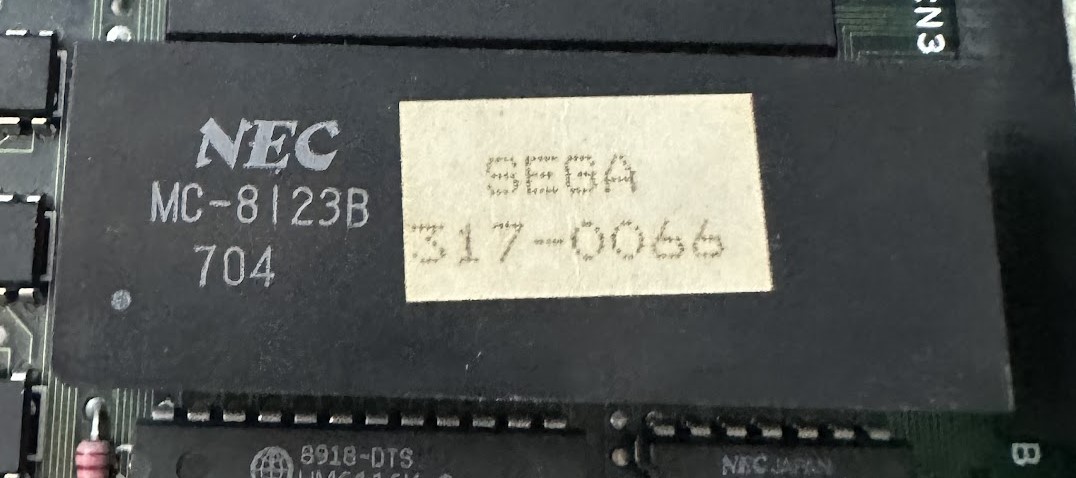
Solutions are identical to an encrypted Main CPU – if the battery hasn’t died yet, it can be replaced by removing the cover, powering the battery leads from a bench PSU, and soldering in a fresh battery. If the battery has died, swap the NEC CPU out for a standard 4.0 Mhz Z80 CPU, swap the Sound CPU ROMs out for decrypted equivalent EPROMs, and the game’s sound should then function again.
Source: Eduardo Cruz
Intel i875 Memory Control Unit (MCU) Protection
Some games utilized an Intel i875 MCU (or clone) that sits between the CPUs and specifically encrypted ROMs that “scrambles” the memory addressing such that a game won’t function without a matching ROM set and MCU.
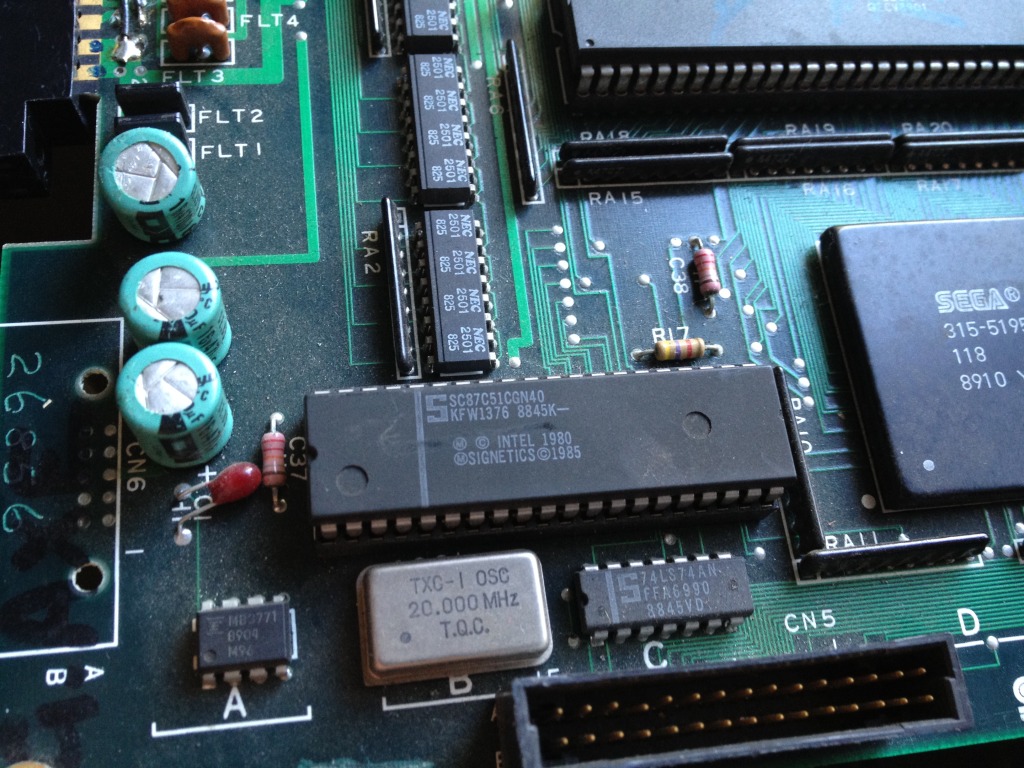
Photo Credit: Womble

Photo Credit: Ebay
Decrypted ROM sets for every System 16B game are available so that the MCU socket can be left empty on the board, and the encrypted mask ROMs can be swapped with decrypted EPROMs to get a fully-functional game.
ROM Board Variants
As mentioned above, Sega utilized four different ROM board variants with the System 16B hardware across the game library. Assuming that no other protection mechanisms were in place, an arcade operator still wouldn’t be able to change one System 16B game over to another one by swapping ROMs unless the same ROM board was used with both games.
MAME documents the ROM board and configuration settings (if applicable) on the ROM board for each game.
Schematics & Datasheets
Original Sega schematics are available for System 16B, but there seem to be discrepancies between them and the real hardware.
Charles MacDonald wrote up extensive documentation on System 16B’s operations.
Charles MacDonald System 16B Hardware Notes
Jotego authored an FPGA core for System 16B and created a set of schematics for the 315-5195 custom IC in the process.
Jotego 315-5195 Schematics (Link)
Jotego 315-5195 Schematics (PDF)
Additional Resources
| MAME Sega System 16B Driver | https://github.com/mamedev/mame/blob/master/src/mame/sega/segas16b.cpp |
| Eduardo Cruz: Deconstructing Sega’s System 16 Security | https://arcadehacker.blogspot.com/2019/10/deconstructing-sega-system16-security-part1.html https://arcadehacker.blogspot.com/2020/04/deconstructing-segas-system-16-security-part2.html |
| Eduardo Cruz: Sega System 16 / 18 / 24 / X Security Programming Guide | http://arcadehacker.blogspot.com/2018/12/sega-system16-security-programming-guide.html https://github.com/ArcadeHacker/ArcadeHacker_Sega_Hitachi |
| Exodus Emulator | http://techdocs.exodusemulator.com/Arcade/SegaSystem16/index.html |
| SOLID-orange – Twistedsymphony’s Projects | http://solid-orange.com/ |
| Jotego System 16B FPGA Core | https://github.com/jotego/jtcores/tree/master/cores/s16b |
